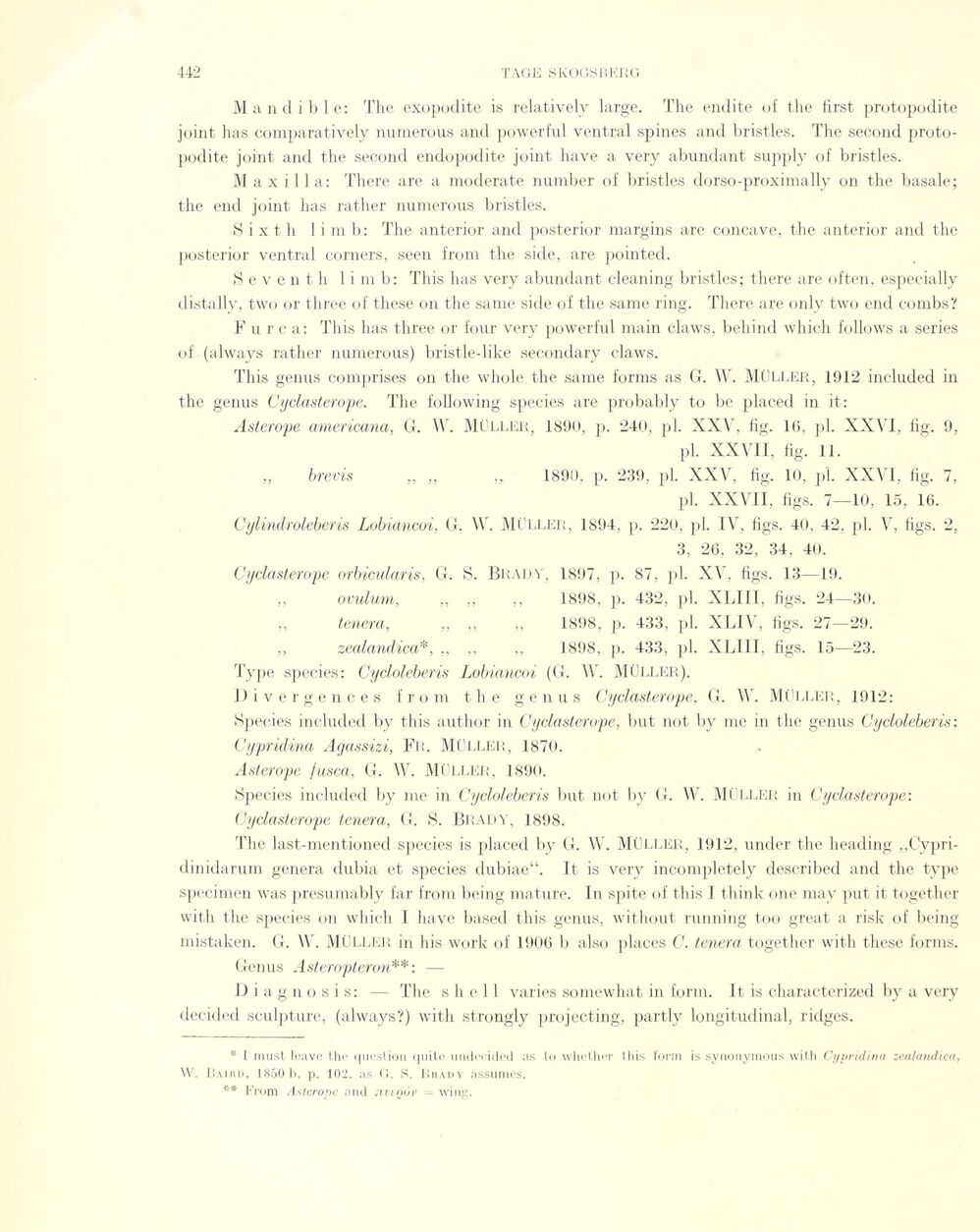
Full resolution (JPEG) - On this page / på denna sida - Sidor ...

<< prev. page << föreg. sida << >> nästa sida >> next page >>
Below is the raw OCR text
from the above scanned image.
Do you see an error? Proofread the page now!
Här nedan syns maskintolkade texten från faksimilbilden ovan.
Ser du något fel? Korrekturläs sidan nu!
This page has never been proofread. / Denna sida har aldrig korrekturlästs.
M a ndi b le: The exopodite is relatively large. The endite of the first pro topodite
joint has comparatively numerous and powerful ventral spines and bristles. The second
protopodite joint and the second endopodite joint have a very abundant supply of bristles.
Maxilla: There are a moderate number of bristles dorso-proximally on the basale;
the end joint has rather numerous bristles.
S i X t h 1 i m b: The anterior and posterior margins are concave, the anterior and the
posterior ventral corners, seen from the side, are pointed.
S e v e n t h 1 i m b: This has very abundant cleaning bristles; there are often, especially
distally, two or three of these on the same side of the same ring. There are only two end combs?
Furca: This has three or four very powerful main claws, behind which follows a series
of (always rather numerous) bristle-like secondary claws.
This genus comprises on the whole the same forms as G. W. MÜLLER, 1912 included in
the genus Cyclasterope. The following species are probably to be placecl in it:
Asterope americana, G. W. Müller, 1890, p. 240, pl. XXV, hg. 16, pl. XXVI, fig. 9,
pl. XXVII. fig. 11.
„ brevis ,, ,, ,, 1890, p. 239, pl. XXV, fig. 10, pl. XXVI, fig. 7,
pl. XXVII, figs. 7—10, 15, 16.
C’ylindroleberis Lobiancoi, G. W. MÜLLER, 1894, p. 220, pl. IV, figs. 40, 42, pl. V, figs. 2,
3, 26, 32, 34, 40.
Cyclasterope orbicularis, G. S. BRADY, 1897, p. 87, pl. XV, figs. 13—19.
,, ovulum, „ ,, ,, 1898, p. 432, pi. XLIII, figs. 24—30.
,, tenera, ,, ,, ,, 1898, p. 433, pi. XLIV, ligs. 27—29.
,, zealandica*, „ ,, ,, 1898, p. 433, pi. XLIII, figs. 15—23.
Type species: Cycloleberis Lobiancoi (G. W. Müller).
Divergences from the genus Cyclasterope, G. W. MÜLLER, 1912:
Species included by this author in Cyclasterope, but not by me in the genus Cycloleberis:
Cypridina Agassizi, Fr. MÜLLER, 1870.
Asterope fusca, G. W. MÜLLER, 1890.
Species included by me in Cycloleberis but not by G. W. MÜLLER in Cyclasterope:
Cyclasterope tenera, G. S. Brady, 1898.
The last-mentioned species is placecl by G. W. MÜLLER, 1912, under the heading
„Cypri-dinidarum genera dubia et species dubiae“. It is very incompletely described and the type
specimen was presumably far from being mature. In spite of this I think one may put it together
with the species on which I have based this genus, without running too great a risk of being
mistaken. G. V . Müller in his work of 1906 b also places C. tenera together with these fornis.
Genus Asteropteron** : —
Diagnosis: — The s h e 11 varies somewhat in form. It is characterized by a very
decided sculpture, (always?) with strongly projccting, partly longitudinal, riclges.
* 1 inust leave the question quite undeeided as tu whether this form is synonymous with Cypridina zealandica.
W. Baird, 1850 b, p. 102. as O. S. Brady assumes.
** From Asterope and fivnQÔv - wing.
<< prev. page << föreg. sida << >> nästa sida >> next page >>